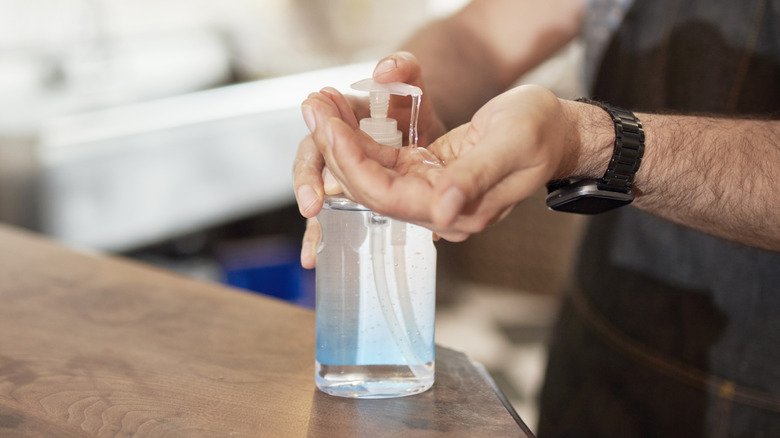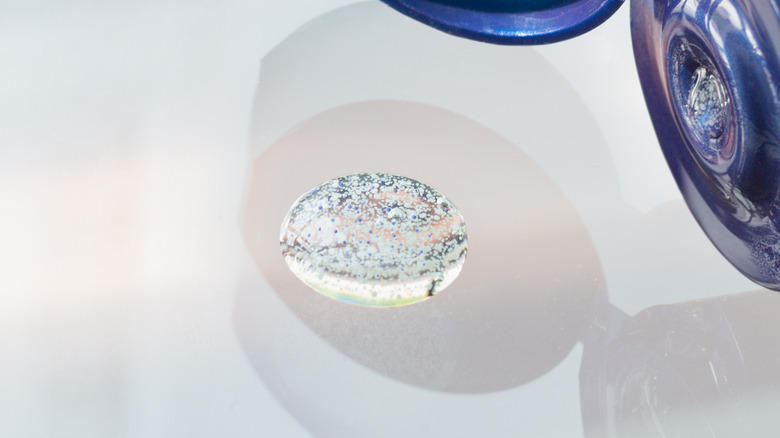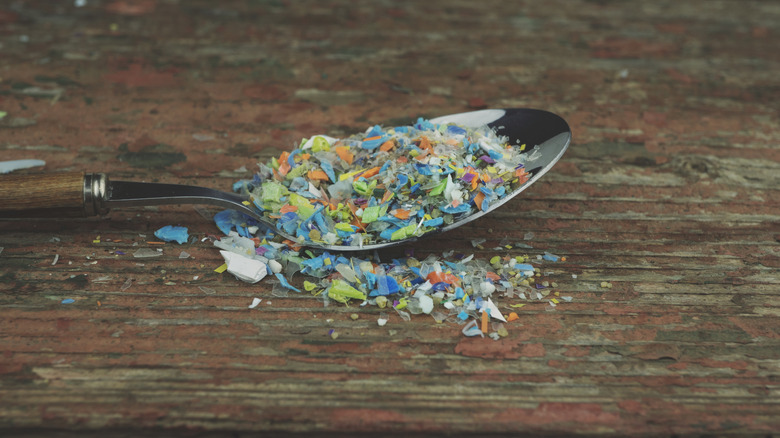What Are The Little Beads In Hand Sanitizer For
Since the world endured a global pandemic we have all, lamentably, become intimately familiar with hand sanitizer and how it works. Which means we've all surely noticed the little beads floating inside the liquid. It's not just in sanitizer, either. Face washes, toothpastes, and other personal care products come with these tiny beads. But what exactly are they, and are they doing anything?
Their actual name is microbeads, and they're very small plastic spheres which are designed to help with exfoliation. These microbeads are added to cosmetic products as a synthetic replacement for naturally occurring exfoliating elements, which all sounds perfectly fine and even helpful. After all, if something can help us remove dry and dead skin cells and unclog pores, why not use it?
Well, it turns out filling our personal care products with tiny pieces of plastic may not actually be all that good for the environment, and may even be harming our health. Here's everything you need to know about microbeads.
What are microbeads and how do they damage the environment
Microbeads are extremely small, measuring no more than 5 mm in size. They're added to cleaning products, printer toners, and industrial products, but most people know them from their personal care products. Microbeads have been around since the late 1960s, when patents for the tiny particles started to emerge. It wasn't until the 1990s, however, that microbead use became widespread in personal care products, with companies adding them to everything from toothpaste to shaving creams and even shampoos.
Aside from helping with exfoliation, microbeads also help to polish teeth and prolong the shelf life of products by trapping and adsorbing degradable ingredients. Unfortunately, there is a big downside to adding these little pieces of plastic to products, one which has become increasingly apparent in recent years.
Before synthetic microbeads were manufactured, companies would use natural ingredients such as cocoa beans, sea salt, or ground pumice, which are biodegradable. Plastic is, of course, not biodegradable, and therefore poses a major environmental, and even a personal health risk. One of the main issues with microplastics is that, due to their miniscule size, they can't be filtered out of wastewater, which means they make it through treatment plants and find their way into lakes, rivers, and oceans. Plastic use in general is already a major problem, with plastic trash having a big effect on ocean food chains. Things aren't getting much better, either. Since 1975, global plastic production has actually increased by 620%, and because plastic isn't biodegradable, it places a huge burden on the environment, especially when poor waste management has failed to adequately deal with the issue. Adding tiny little pieces of plastic to the environment might not seem like the most obviously terrible addition to this problem, but it's actually much more serious than you might imagine.
The health risks of microbeads
Once microbeads make it out of wastewater treatment plants and into rivers, lakes, and oceans, they can be eaten by aquatic life and birds. Since the plastic pieces can pick up harmful toxins and chemicals, these then find their way into wildlife, and pollute the food chain. It's not as if there's a small amount of these microbeads out in the environment, either.
A 2013 study published in Marine Pollution Bulletin found that the Great Lakes have higher concentrations of plastic pollutants than any other body of water on Earth. The study removed microplastic particles from the lakes, and found that many of the samples were "multi-colored spheres" which were suspected to be microbeads from consumer products. The study also noted that plastic pollution is the dominant form of debris found in marine environments.
Ultimately, these small pieces of plastic could make it into the food chain, which would be concerning enough on its own, but as Philippe Van Cappellen, an ecohydrology professor at the University of Waterloo, told CBC, the microbeads have a large surface relative to their mass which allows contaminants to accumulate on them. More specifically, synthetic chemical compounds that are thought to cause cancer or birth defects can gather on the microbeads, and if they then find their way into the food chain, it could have major consequences for our health. Indeed, a 2023 study published in the Yonsei Medical Journal notes how cellular and animal experiments have shown that microplastics can affect the human body in numerous ways, from digestive and respiratory issues to disruptions to the endocrine, reproductive, and immune systems. Thankfully, there is something you can do about it, at least on a personal level: There's a simple kitchen hack that can remove up to 90% of microplastics from your water.


